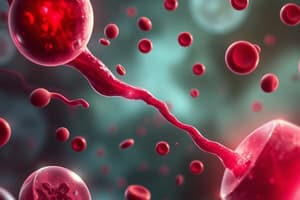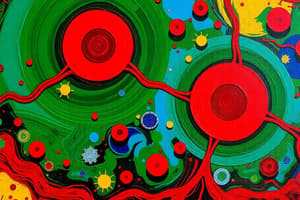Podcast
Questions and Answers
What is the primary role of platelets in the body?
What is the primary role of platelets in the body?
- Fight infections
- Regulate body temperature
- Transport oxygen
- Form clots and prevent bleeding (correct)
Platelets have a lifespan of 30 days.
Platelets have a lifespan of 30 days.
False (B)
What initiates the constriction of blood vessels after an injury?
What initiates the constriction of blood vessels after an injury?
Local myogenic contraction, nervous reflexes, and local humoral factors.
Platelet aggregation is crucial for forming a __________ plug.
Platelet aggregation is crucial for forming a __________ plug.
Which of the following substances is released from platelets during activation?
Which of the following substances is released from platelets during activation?
Match the following components with their roles in hemostasis:
Match the following components with their roles in hemostasis:
The intrinsic pathway of coagulation is triggered by an external factor.
The intrinsic pathway of coagulation is triggered by an external factor.
What is the final step of blood coagulation?
What is the final step of blood coagulation?
Flashcards
Platelets (Thrombocytes)
Platelets (Thrombocytes)
Small, colorless cell fragments in blood that form clots to stop bleeding.
Platelet Adhesion
Platelet Adhesion
Platelets sticking to the damaged blood vessel wall (collagen).
Platelet Activation
Platelet Activation
Platelets change shape, swell, and release the contents of their granules.
Platelet Release Reaction
Platelet Release Reaction
Signup and view all the flashcards
Platelet Aggregation
Platelet Aggregation
Signup and view all the flashcards
Platelet Fusion
Platelet Fusion
Signup and view all the flashcards
Vasoconstriction
Vasoconstriction
Signup and view all the flashcards
Hemostatic Plug
Hemostatic Plug
Signup and view all the flashcards
Blood Coagulation
Blood Coagulation
Signup and view all the flashcards
Coagulation Cascade
Coagulation Cascade
Signup and view all the flashcards
Study Notes
Platelets
- Platelets, also known as thrombocytes, are small, colorless cell fragments in blood.
- Their role is to form clots to stop or prevent bleeding.
- Platelets are produced in bone marrow.
- Platelets have a lifespan of 8 days.
Blood Vessel Constriction
- Blood vessel constriction occurs immediately after injury.
- This constriction helps decrease blood loss at the injured site.
- Causes of vasoconstriction include:
- Local myogenic contraction due to direct trauma.
- Nervous reflexes triggered by pain from the injured vessel.
- Local humoral factors released by platelets, such as ADP, serotonin, and thromboxane A2.
Formation of a Temporary Hemostatic Plug
- Platelet aggregation forms a temporary hemostatic plug in the early stages of hemostasis.
- Injury to a vessel stimulates platelets to form a mechanical plug to seal the damaged area.
Platelet Reactions in Hemostasis
- Platelet adhesion: Platelets adhere to exposed subendothelial collagen after blood vessel injury.
- Platelet activation: After adhesion, platelets change shape and release granule contents.
- Platelet release reaction: Platelets release granules containing ADP, serotonin, and thromboxane A2, playing a role in clot formation.
- Platelet aggregation: Platelets adhere to each other at sites of vascular injury, crucial for hemostatic plug formation and thrombosis.
- Platelet fusion: An irreversible slow process where aggregated platelets fuse at the injury site, caused by high ADP concentration and thrombin.
Blood Coagulation
- The clotting mechanism converts temporary platelets plugs into definitive clots using fibrin.
- Coagulation factors, plasma proteins synthesized by the liver, are activated in a cascade.
- The final step in coagulation is the formation of a fibrin mesh.
Blood Coagulation Pathways
- Intrinsic Pathway: Initiated within the blood itself by factors activated within the vascular system.
- Extrinsic Pathway: Initiated by factors and tissues outside the bloodstream (e.g., trauma to the blood vessel.)
Studying That Suits You
Use AI to generate personalized quizzes and flashcards to suit your learning preferences.



